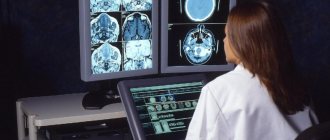A hallucination is an image that appears in a person’s mind without an external stimulus. The condition develops with severe fatigue, alcohol intoxication, and exposure to narcotic/psychotropic substances. Hallucinations can also be a symptom of certain mental and neurological diseases. What happens to consciousness, on what principle does a hallucination develop, and in what cases is it necessary to consult a doctor?
Symptoms of auditory hallucinations
Despite the fact that auditory hallucinations can occur for a variety of reasons and have different manifestations, their symptoms are largely similar. This illness is that a person hears voices and sounds that are not really there. But at the same time, he can often sincerely believe in their reality and not understand that all this only seems to him. It is interesting that this phenomenon can sometimes occur not only with all kinds of diseases or painful conditions, but also in some conditions in completely healthy people.
Symptoms of auditory hallucinations include a variety of voices and sounds. It can be human voices, barking dogs, various creaks, rustles, rattles, the roar of a car or other engine, whistles, laughter, the sound of water and much more. At the same time, many people can hear completely understandable phrases or words. Some types of such hallucinations pose virtually no danger to both the patient himself and those around him, while others can cause serious harm to himself or jeopardize public safety.
Professional psychiatrists often divide such hallucinations into true and false. In the presence of true hallucinations, their manifestation seems quite realistic. Therefore, a person has no doubt that these voices and sounds actually exist. And with false hallucinations, the person with whom this phenomenon occurs also doubts the reality of this phenomenon.
Most of these voices and sounds are practically harmless to the patient himself and the people around him. This phenomenon can only complicate the patient’s life. In many cases, it contributes to the disruption of his work and social life, impairs sleep and interferes with the conduct of many usual activities.
And the most dangerous are hallucinations, which are usually called imperative. In this case, the voices that inhabit his head and seem very real may force him to kill someone or himself, steal something, or commit other dangerous or illegal actions. The patient may be forced to drive a car at high speed, jump from great heights, commit suicide, or engage in self-harm. At the same time, he is completely confident in the reality of such voices and phrases, and therefore often, without a shadow of a doubt, commits such dangerous and criminal actions against himself or other people. Such events must be properly distinguished from deliberate actions.
Diagnostic measures
Attacks of auditory hallucinations are specific manifestations of many diseases of a mental or somatic nature . During diagnosis, the main task of the doctor is to identify the disease that led to the occurrence of attacks. Diagnostic measures begin with the collection of anamnesis data. In some cases, this task is complicated by the fact that the patient is not able to critically assess what is happening. Many patients are hostile towards the specialist, which leads to difficulties in creating a communicative connection. In this situation, a survey is conducted among the patient's closest relatives.
After this, laboratory and instrumental studies are carried out to identify somatic diseases. This category of diagnostic methods includes: the study of analyzes of cerebrospinal fluid, urine and blood. Magnetic resonance and computed tomography, as well as electroencephalogram, can be used as additional diagnostic tools.
In situations where patients using hearing aids complain of auditory hallucinations, testing of the equipment is included in the diagnosis. In some cases, the cause of extraneous noise is a malfunction of the electronic device.
In psychiatric practice, “voices in the head” occur in a significant number of diseases
In the case of mental pathologies that are accompanied by such attacks, the final diagnosis is established based on the severity of clinical symptoms. The presence of hallucinatory attacks can be recognized through a detailed analysis of the patient’s behavior. When answering questions, people with a similar problem make short pauses, as if listening to a quiet voice. During a conversation with a patient, the doctor must create the most trusting connection possible. Otherwise, it is unlikely that it will be possible to obtain a complete clinical picture.
Causes of auditory hallucinations
The causes of auditory hallucinations can be very different. Despite the fact that most often they are a manifestation of various mental illnesses, this phenomenon is also inherent in poisoning with all kinds of psychoactive substances. In addition, hallucinations may indicate other diseases and conditions that are not mental. There are also cases when they appeared in healthy people under certain conditions.
In the modern world, a very common cause of such hallucinations is poisoning of the body with psychotropic substances such as alcohol and various types of drugs. However, such people are not always recognized as drug addicts or alcoholics. In addition, the phenomenon can also occur during ordinary household poisoning with various poisons, food products of poor quality, household chemicals, all kinds of gases, etc.
Hallucinations are common in people with mental illness. Voices and sounds can be heard by patients with schizophrenia, Alzheimer's disease, senile dementia and similar diseases. Similar phenomena can occur with traumatic brain injuries, brain tumors, and certain types of infectious diseases that affect brain activity. In addition, they can result from a strong increase in body temperature and some other painful conditions.
In addition, sometimes completely healthy people can hear various voices that do not really exist. This sometimes happens during severe fatigue, when a person has not slept for several days in a row, and in some individuals, upon awakening, when it is difficult to draw the line between reality and sleep. Sometimes people can react in this way to the death or serious illness of loved ones, violence or other serious psychological shock. Auditory hallucinations can occur in people of all ages, from young children to the elderly.
Sexually transmitted diseases and paranoia
The above reasons are the most common. However, in reality there are many more of them. For example, some sexually transmitted diseases (syphilis) can cause similar symptoms. People who use various medicinal substances can also suffer from severe auditory cacophonies.
We have described the main causes of imperative hallucinations, but we must not forget that the human body ages, numerous pathological changes occur in it, leading to the emergence of senile paranoia, which also causes similar symptoms in people.
Types of auditory hallucinations
Such hallucinations can be very different. At the same time, they are divided into true and false. The patient can clearly hear different words and phrases, as well as human voices and sounds of wildlife, car sirens, barking dogs, ringing bells and many other sounds.
Professional psychiatrists identify the following types of auditory hallucinations:
- Tinnitus is all kinds of noises like whistling, grinding, crackling, and the like;
- Acoasms are sounds that differ in specificity. These may include dripping water, the sound of the surf, wind, the sound of rain, barking dogs, the noise of cars, the howl of a siren, the ringing of bells and sounds close to them;
- Phonemes - this type of auditory hallucination is often considered the most dangerous. After all, when it appears, the patient can clearly hear certain words and phrases, sometimes spoken by a specific and very real person. In many cases, such illusions can be very dangerous for the one who hears them or for the people around him.
Auditory hallucinations in adolescents
Auditory hallucinations are quite common in adolescents. In many cases, they are caused by all sorts of psychological problems in relationships with parents and peers, difficulties in growing up and puberty, and can also be the result of violence or severe shock.
In addition, traumatic brain injuries are common in adolescence, which can also lead to auditory illusions. They can also be the result of infectious diseases or occur at high temperatures.
Modern schoolchildren, often under the influence of older friends, actively experiment with alcohol or drugs. Often their overdose leads to the formation of various types of hallucinations, including auditory ones.
Also, this phenomenon in a teenager can be a consequence of mental illness.
Medicines
Treatment is usually carried out with the help of medications, the list of which usually includes the following drugs:
- "Tizercin";
- "Plegomazin";
- "Thorazine";
- "Gibanil";
- "Largactil";
- "Aminazine";
- "Chlorpromazine";
- "Ampliaktil";
- "Megafen";
- "Amplictil";
- "Contamine."
One of the most prescribed medications for imperative hallucinations is Aminazine, which is used for intramuscular or intravenous administration.
Treatment for this disease depends on the causes of the problem. These can be sedatives, antipyretics, anti-inflammatory, neurostimulating medications, as well as medications for the treatment of central nervous system pathologies and mental disorders.
The patient may be prescribed auxiliary therapy, for example, electrical stimulation treatment is often used, which specifically affects specific sections.
Auditory hallucinations in children
Auditory hallucinations in children of preschool and primary school age are a very common phenomenon. At this age, they are often caused by fever, various infectious diseases and traumatic brain injuries. But they can also appear due to violence, serious psychological shock as a result of any events they have seen or experienced that are terrible for them. Poisoning with various poisons and toxic substances can also cause a similar phenomenon. In addition, such hallucinations sometimes indicate the presence of a mental illness. But sometimes similar illusions arise in healthy children due to severe fatigue.
Treatment methods
Treatment of hallucinations in older people is aimed at eliminating the underlying disease that caused the appearance of this symptom. The main goal of therapy is to stop possible attacks. Most patients in this condition require emergency hospitalization in a specialized facility. The treatment strategy is selected on an individual basis, and the process itself proceeds under close medical supervision.
It is important to understand that self-medication can only aggravate the patient’s condition and have a detrimental effect on his health.
Often, auditory hallucinatory attacks accompany the development of a disease such as schizophrenia. In this case, a medicine from the group of antipsychotic drugs is used. Long-term use of these medications can reduce the risk of relapse. When attacks of hallucinations are a consequence of consuming pharmacological products, it is the doctor’s responsibility to adjust the dosage or select less harmful analogues.
Auditory hallucinations after alcohol binge
After an alcoholic binge, all kinds of hallucinations often appear, including auditory ones. Moreover, they are often very dangerous and can lead to very unpleasant or terrible consequences. Indeed, in such a state, the alcoholic experiences various fears, cannot sleep normally and react to the surrounding reality. This phenomenon is caused by exhaustion of the body by prolonged consumption of large quantities of alcoholic beverages, often low-quality or surrogate ones. Many alcoholics in this state may hear distinct voices that tell them to cause significant harm to their own health or commit some other illegal or dangerous act. Therefore, often after a few days after drinking, many drinkers commit suicide, murder, or become guilty of serious road accidents.
What is a waking dream
The phenomenon of a waking dream is well described by Jack London in the novel Straitjacket. Agronomy professor Darrel Standing, sentenced to death, is subjected to regular torture in a straitjacket, with the help of which he eventually learns to travel through time and the world in a transformation between a sleepy state and reality.
There are many practitioners who try to practice this state. A waking dream is the line between reality and sleep, when the body seems to be already asleep, but the brain still gives all the signals characteristic of wakefulness. The state in a dream and in reality differs in that in a dream the brain is already completely asleep. How to induce a waking dream?
To avoid headaches after waking up, you need to learn some safety rules:
- do not set an alarm clock with a sharp sound;
- It’s better to be woken up by soft, gradually increasing volume music or a friend with a light touch;
- for the first time try to fall into a waking sleep for 2 minutes and then gradually increase the time of waking sleep to half an hour;
- Try not to let anything bother you during this time.
How to induce a waking dream
- Turn on a night light so you don't get disoriented when you wake up.
- Take a lying position on the floor. You can lay foam or a blanket. You need to lie on your back, stretch out your arms, and close your eyes.
- Breathe exactly 3 seconds per inhalation and exhalation. Slowly increase the length of your inhalation/exhalation until you feel dizzy and see black spots before your eyes.
- Try not to think about anything, imagine a peaceful landscape, the chirping of birds, the sound of a waterfall.
- Do not move under any circumstances. At some point you will feel immersed in a state between sleep and reality.
- Now open your eyes. From this point on, have your observer friend begin counting the time.
- Now you will find yourself in the unreal space of your subconscious, your mind will wander in the labyrinths of the subconscious.
- After waking up, you don’t need to get up suddenly. Adapt a little to reality.
This is a very interesting and unusual experiment.
List of used literature:
- Vinnik D.V. Ontological status of hallucinations in the concept of indirect realism // Philosophy of science. — Novosibirsk: Institute of Philosophy and Law SB RAS, 2008. — No. 1
- Esquirol J.-E. D. About hallucinations in mentally ill people. — Paris, 1817
- Goghari VM, Harrow M, Grossman LS, Rosen C (June 2013). “A 20-year multi-follow-up of hallucinations in schizophrenia, other psychotic, and mood disorders.” Psychol Med. 43 (6): 1151–60
How to treat auditory hallucinations
If signs of this phenomenon occur, you should not self-medicate, as it can pose a serious and even fatal danger to the body. Also, you should not hope that hallucinations will go away on their own without medical intervention. Therefore, a person who observes such symptoms in himself or his loved ones should not think about how to treat auditory hallucinations, but should consult a doctor as soon as possible. At the same time, it is not at all necessary that this problem will be treated by a psychiatrist, whom many people are very afraid to contact. After all, such auditory phenomena often occur in diseases or conditions not related to psychiatry. And the very appeal to a psychiatrist does not mean at all that such a person will be declared incompetent and will soon become an outcast from society. Modern psychiatry is very far from what it was in the twentieth century. Now many diseases that were previously considered incurable or socially dangerous are quite amenable to drug therapy.
Fears
Patients who have not yet completely lost their minds share their fears with a specialist. As a rule, they are afraid that during the next attack the voices will order to cause physical harm to someone around them, since during such an attack the person loses the ability to control his thoughts and actions. His will is so suppressed that he is unable to resist what is happening to him.
Mostly the voices directly address the patient, but they do not call him by name. Quite rarely, voice orders can relate to abstract or long-term actions; as a rule, such instructions affect exclusively the “here and now”.
How to get rid of auditory hallucinations
In addition, often the answer to the question: “How to get rid of auditory hallucinations?” The psychologist also knows. Contacting him will be advisable if this problem is caused by violence, psychological trauma, severe fear or puberty in adolescents.
If such hallucinations are suspected in children, parents should be able to distinguish this problem from the manifestation of a child’s violent imagination or the child’s retelling of his dreams. And parents of teenagers, if they have sound or other hallucinations, should exclude the abuse of alcohol, drugs and other psychoactive or toxic substances.
Diagnostics
Sound hallucination is a sign of a certain disease. Therefore, a specialist must identify the cause of its occurrence.
The examination begins with a conversation with a specialist. Laboratory tests and instrumental studies will help exclude the physiological nature of the disease. If an elderly person who uses a hearing aid complains of sound anomalies, the diagnosis begins by checking the device.
The presence of a disorder may be indicated by the patient's inappropriate behavior.










